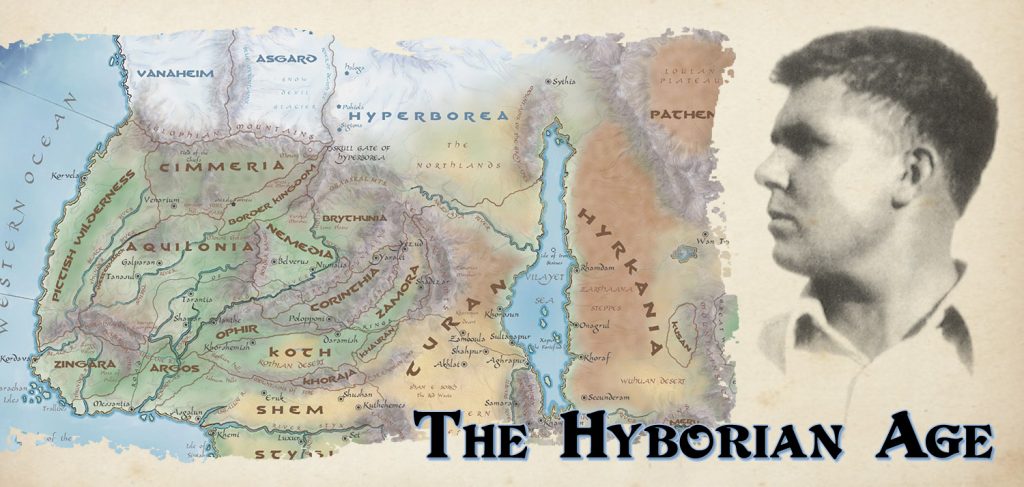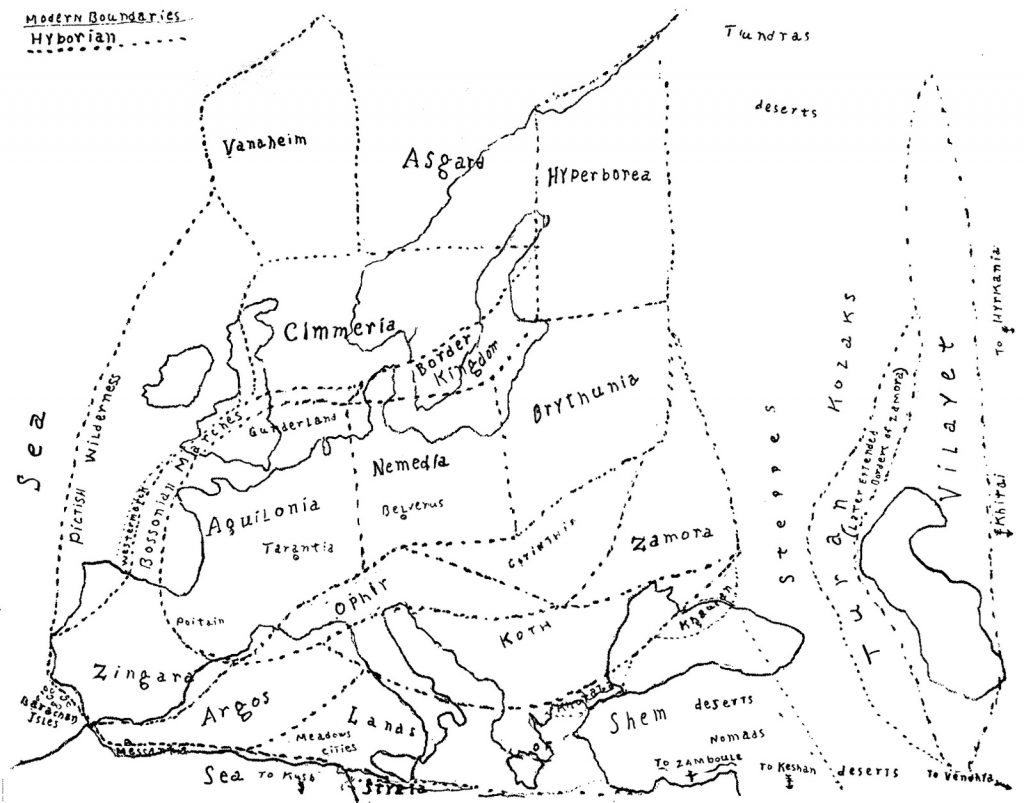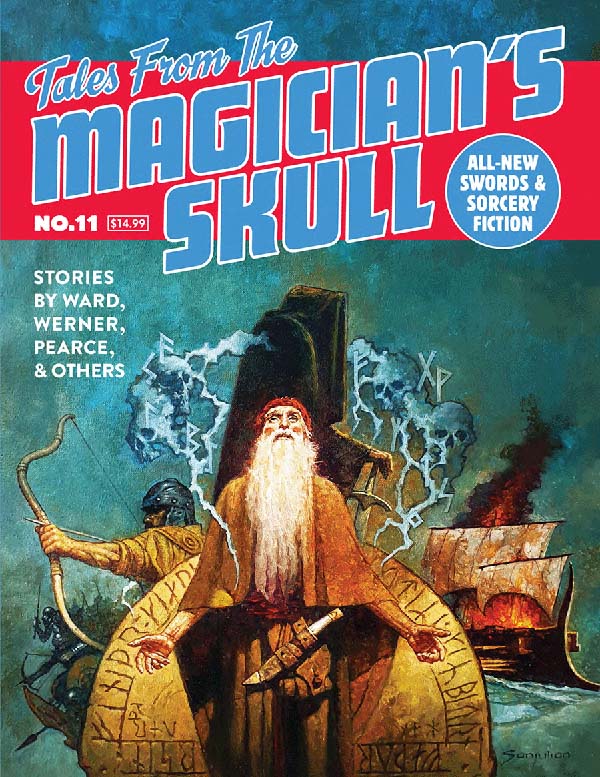Hyborian Age World Building
by Bill Ward
Robert E. Howard, pioneer of sword & sorcery fiction, creator of Conan and Solomon Kane, author of scores of stories across half a dozen genres or more, is rightly praised as a master of pacing, a crafter of visceral action, and a writer of vivid and poetic prose. What often goes unremarked, even among his ardent fans, is Howard’s impressive achievement as a world-builder, namely in the form of his setting for the Conan stories, the Hyborian Age. That this “age undreamed of” doesn’t stand out in the way that, say, Middle Earth does, is in fact a testament to its effectiveness—because it was never supposed to draw attention to itself in the first place.
While many modern secondary world fantasies are designed to create interesting hooks or puzzles about the worlds themselves, and thus engage the reader’s curiosity to learn more about the strange and exotic workings of such settings, Howard’s intentions were just the opposite, and for good reason. There is an enormous difference between the amount of background material one can insert into a novel versus a short story. Modern fantasy’s multi-volume epics are a far cry from the lightning fast stories of the pulps. From a purely practical point of view, pulp magazine fiction can’t indulge in such worlds unless their uniqueness is the entire point of the story, something which simply won’t work for an ongoing series delivered in small, sporadic, and standalone installments.
Series fiction of this kind has to stand on its own with every story. Just as a character like Conan can’t rely on some complicated backstory or a reader’s foreknowledge of his prior adventures to be comprehensible, neither can any other aspect of a series story. But there is a kind of foreknowledge readily available in fiction, something not reliant on the author’s previous work or invented world, and that is the reader’s own knowledge of story. In the case of characters, this foreknowledge is in the form of character archetypes. For things like magic swords, dwarven hoards, and perilous quests, we have tropes. But for a story’s setting, it is the history, culture, and geography of our own world that a writer calls upon in order to communicate more with less.
Howard certainly was not the first or only writer to use real or archaic place names, or those that sound similar, when creating imaginary worlds. And, in a time before the secondary world was the firmly established trope of fantastic fiction that is now almost a sub-genre unto itself, many others set their fantasies in a never-never land that was just over the next horizon, or in some tiny, overlooked corner of the map. Much of what we might today regard as the genre of historical adventure happily played fast and lose with actual events, people, and places, so much so that even a locale firmly established as part of the real world may have more to do with the author’s imagination than any research he might have done.
Not so Howard. A lover of historical adventure, Howard was also more importantly a lover of history, and he cared about getting history right. And he did a good job of doing just that in the historical fiction he did craft. But here is where he ran into several limitations. Firstly, for a writer of pulp fiction for whom productivity was absolutely necessary if he was to have any kind of career, research took time away from writing. A lot of time. Secondly, and perhaps even more significantly, Howard was living in a very small town in rural Texas in the era prior to WWII. Even his contemporaries in populous east coast cities would have had difficulty finding certain sources, but for Howard the dearth of such material was acute. He was thus naturally pushed in the direction of inventing his own worlds. And such invented landscapes would further free him to explore a host of anachronistic possibilities through the persistent lens of a Conan adventure, everything from Medieval France to the Ancient Near East, Caribbean Pirates to the American Frontier could serve as the foundation for one of his tales.
And it wasn’t just the settled facts of history that fascinated and inspired Howard, but its unresolved mysteries. Tantalizing speculations of lost continents and entire fallen civilizations inflamed his imagination. Much of the anthropological and archaeological theorizing that Howard absorbed has been discredited by decades of further advancement, but many such notions as to the origins of various peoples were not so outlandish in his day. It was naturally to a pre-historic age that he first turned to give himself the sandbox he needed to write series fiction, to the age of Kull of Atlantis.
It is something of a disservice to the King Kull stories that they are so often discussed only in light of the Conan series that follows them, but it simply isn’t possible to look at the origins of Conan and his world without mentioning Kull. “The Phoenix on the Sword,” the first Conan story, is an extensive re-write of the last Kull story “By This Axe I Rule!” Both characters are exile wanderers who gain – and keep – a throne by dint of their own strength and cunning. While Kull’s influence on Conan is immediately obvious, the shadow his world casts on the later Hyborian Age is perhaps less so.
The Age of Conan, the Hyborian Age, begins with the cataclysmic destruction of Kull’s own era that sees entire continents and nations blotted out, and the civilized and the barbarous alike thrown back into the stone age. Thus begins Howard’s essay on the topic “The Hyborian Age,” a sequence of invented history initially intended only for Howard’s personal use in setting down the parameters of his new setting. The essay itself is at once illuminating and, perhaps, strangely incomplete – it contains less concrete information about the people and nations of Conan’s world than it does about their antecedents and, interestingly enough, their inevitable destruction. For Howard, history was a cycle, the endless thesis and antithesis of civilization and savagery, and nothing in it could truly exist without also containing the promise of its own destruction.
And so, in the course of Howard’s “artificial legendry” (as Lovecraft would term it), we see the now familiar kingdoms of Asgard and Stygia, Aquilonia and Shem, Nemedia and Argos, and others of his age form out of the remnants of the old world. Always fascinated by the migration of peoples and the multiple layers of settlement and conquest so pronounced in ancient European history, Howard seeds his own turbulent era of mass exodus not only the with movements of mysterious and long lost peoples such as the Lemurians, but with the literal devolution of whole peoples into semi-human status, and their eventual rise back up the evolutionary ladder. Here is the cycle of history applied not simply to nations and cultures, but to the physiology of mankind itself.
This was an abiding fascination of Howard’s, and seems to have driven much of his perspective on history, whether of the real or imagined kind. It is in some ways a mirror of the underlying theme of H.P. Lovecraft’s work, that of the cosmic insignificance of man. For Lovecraft, it was the enormity of the universe that shrunk human beings down to the microscopic. For Howard, it was the uncaring tidal forces of history that dwarfed the best efforts of mankind to strive and organize, and ultimately doomed all enterprises to futility. This pessimism permeates the world of Conan, littered as it is with the decadent, isolated, dysfunctional remains of a far older world. And Conan’s world, too, will come to pass, even as we readers enjoy our escape to such a place, even as some of us may reflect on the ephemeral nature of our own place and time. It is a notion intimately familiar to Conan himself as he laughs in the face of death, “tread(s) the jeweled thrones of the Earth under his sandalled feet,” and shows us with vivid purpose the existentialist solution to a universal mortality—his, and also that of his creator’s.








